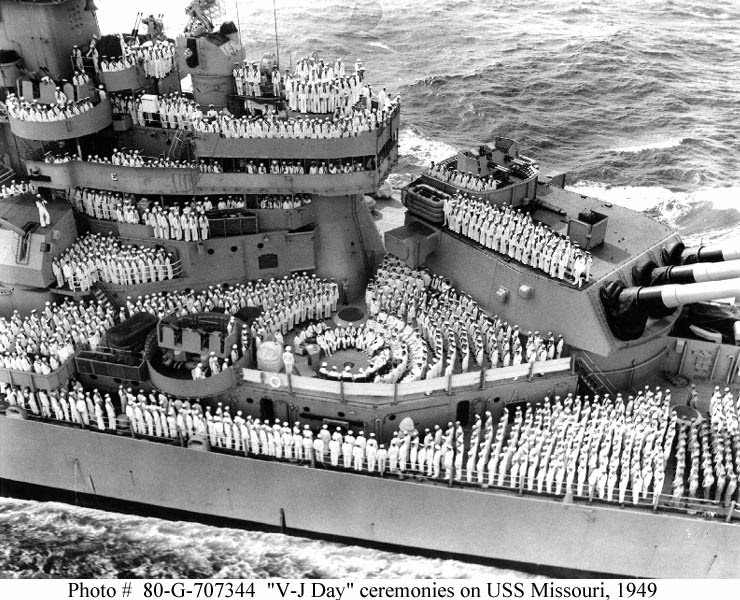So here's a great story behind the photo of Kamikaze pilot hitting the Mighty Mo:
Source:
A great example that war at sea isn't only about warships which fight but about those who serve their country with dignity. Brother of Captain William M Callaghan, Daniel J Callaghan, died earlier during the battle off Savo Island as commander of Task Group 67.4...
Japanese kamikaze pilot
A man sits alone with his thoughts in his one-man, bomb-carrying aircraft on April 11, 1945. He has said goodbye to his family and friends through farewell letters and poems and he has left behind the life he once lived. He sits wedged between 550-pound bombs and prepares to take off, knowing he will never land safely again. Motivated by obligation and loyalty, he is about to give his life for his country. He is a whose mission is to fly his aircraft to his death into the USS Missouri during the battle of Okinawa in World War II.
The tell-all tour
On Sept. 22, 2010 Pearl Harbor volunteer and expert Rich Costick led University of Hawaii’s journalism students on a special VIP tour of the Iowa-class battleship, the USS Missouri. As he tells the stories of the ship’s memorable past, we walk the deck, thinking back to what it must have been like on board.
He tells us of the historical moment that Japan’s surrender to the Allied Forces document was signed on board the Mighty Mo on Sept. 2, 1945, ending WWII. We even learn how they loaded the 67-foot, 116-ton guns that could fire a 2,700-pound shell 23 miles in 50 seconds.
A story to remember
One story, in particular, that caught my attention was that of the Tokkotai (an abbreviation for “Special Attack Unit”) pilots, also known to Americans as “Kamikaze.” I read the information boards on the deck of the ship and stood in awe looking at the pictures of the Japanese dive-bombing into the side of the USS Missouri. The famous picture was taken by the ship’s baker, Seamen Len Schmidt.
The incident occurred 10 days into the battle of Okinawa. The pilot, believed to be 19-year-old Setsuo Ishino, took off with 15 other pilots from their base at Kanoya. At noon, the USS Missouri is northeast of Okinawa and air defense is sounded as the “Zeke” is spotted on radar 7,500 yards out. The Zeke loses altitude rapidly as Mighty Mo’s anti-aircraft fire hits. Miraculously, the pilot regains altitude and speeds through the gunfire, managing to strike the side of Mighty Mo. Fire erupts and debris is sent flying on deck. After the attack, the crew clears the deck of the aircraft’s remains and discovers the pilot’s body among the wreckage.
As Mighty Mo’s seamen were about to wash the enemy body overboard, Captain William M. Callaghan, Missouri’s commanding officer, orders the ship’s medical team to prepare the body for a burial at sea.
The body was draped with a Japanese flag sewn by Missouri crew and carried on deck. The crew gathered and offered a hand salute as the Marine rifles aim their weapons skyward to render a salute over the pilot’s remains. Senior Chaplain, Commander Roland Faulk, concludes the ceremony by saying, “We command his body to the deep,” and his body is dropped into the ocean.
Humanity, equality, honor
This ceremony holds an important significance in our history because of the respect and honor given to the enemy by the Americans amidst a raging war. Costick explains Captain Callaghan’s admirable dignity and honor. Costick tells us that he “looked at it as..this man is serving in his military the same as any of us are, he’s just doing his job. And he’s performed with honor and paid the ultimate price. He deserves to be treated like a warrior. The fact that the ceremony was held and that this man was treated this way showed a lot of compassion on the part of Callaghan.”
I try to imagine what it must have been like for 19-year-old Ishino’s family at the time. To find out their son received the respect and honor from the American enemy must have been life-changing news for them. He was treated as if he was an American soldier, dying for his country.
Kamikaze attack on USS Missouri: The last bit of information I read before moving on with our tour was, “On April 11, 2001, family members of three Japanese pilots as well as the family of former commanding officer Captain William M Callaghan gathered aboard Missouri to honor the courage and compassion in recognizing our common humanity …even in the midst of war.” This inspiring story restores our faith in humanity and the pure goodness that exists in some people’s hearts.
Source:
A great example that war at sea isn't only about warships which fight but about those who serve their country with dignity. Brother of Captain William M Callaghan, Daniel J Callaghan, died earlier during the battle off Savo Island as commander of Task Group 67.4...
Last edited:




